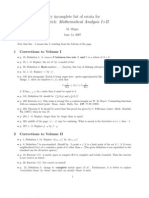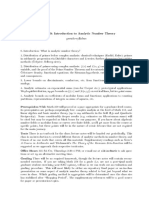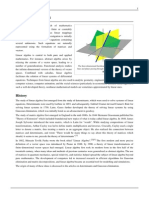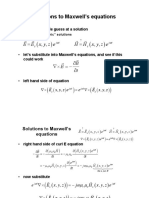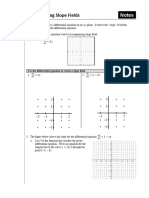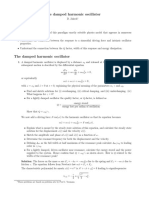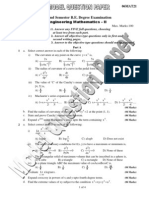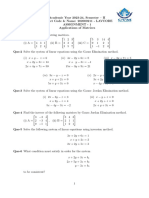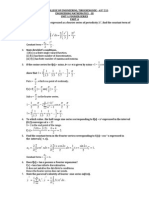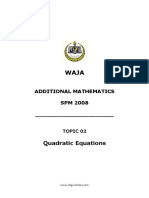Calculus of Variations
Calculus of Variations
Uploaded by
Jose Luis CondoriCopyright:
Available Formats
Calculus of Variations
Calculus of Variations
Uploaded by
Jose Luis CondoriCopyright
Available Formats
Share this document
Did you find this document useful?
Is this content inappropriate?
Copyright:
Available Formats
Calculus of Variations
Calculus of Variations
Uploaded by
Jose Luis CondoriCopyright:
Available Formats
Calculus of variations
1
Calculus of variations
"Variational method" redirects here. For the use as an approximation method in quantum mechanics, see Variational
method (quantum mechanics).
Calculus
Fundamental theorem
Limits of functions
Continuity
Mean value theorem
Rolle's theorem
v
t
e
[1]
Calculus of variations is a field of mathematical analysis that deals with maximizing or minimizing functionals,
which are mappings from a set of functions to the real numbers. Functionals are often expressed as definite integrals
involving functions and their derivatives. The interest is in extremal functions that make the functional attain a
maximum or minimum value or stationary functions those where the rate of change of the functional is zero.
A simple example of such a problem is to find the curve of shortest length connecting two points. If there are no
constraints, the solution is obviously a straight line between the points. However, if the curve is constrained to lie on
a surface in space, then the solution is less obvious, and possibly many solutions may exist. Such solutions are
known as geodesics. A related problem is posed by Fermat's principle: light follows the path of shortest optical
length connecting two points, where the optical length depends upon the material of the medium. One corresponding
concept in mechanics is the principle of least action.
Many important problems involve functions of several variables. Solutions of boundary value problems for the
Laplace equation satisfy the Dirichlet principle. Plateau's problem requires finding a surface of minimal area that
spans a given contour in space: a solution can often be found by dipping a frame in a solution of soap suds. Although
such experiments are relatively easy to perform, their mathematical interpretation is far from simple: there may be
more than one locally minimizing surface, and they may have non-trivial topology.
History
The calculus of variations may be said to begin with the brachistochrone curve problem raised by Johann Bernoulli
(1696). It immediately occupied the attention of Jakob Bernoulli and the Marquis de l'Hpital, but Leonhard Euler
first elaborated the subject. His contributions began in 1733, and his Elementa Calculi Variationum gave to the
science its name. Lagrange contributed extensively to the theory, and Legendre (1786) laid down a method, not
entirely satisfactory, for the discrimination of maxima and minima. Isaac Newton and Gottfried Leibniz also gave
some early attention to the subject. To this discrimination Vincenzo Brunacci (1810), Carl Friedrich Gauss (1829),
Simon Poisson (1831), Mikhail Ostrogradsky (1834), and Carl Jacobi (1837) have been among the contributors. An
important general work is that of Sarrus (1842) which was condensed and improved by Cauchy (1844). Other
valuable treatises and memoirs have been written by Strauch (1849), Jellett (1850), Otto Hesse (1857), Alfred
Clebsch (1858), and Carll (1885), but perhaps the most important work of the century is that of Weierstrass. His
celebrated course on the theory is epoch-making, and it may be asserted that he was the first to place it on a firm and
unquestionable foundation. The 20th and the 23rd Hilbert problem published in 1900 encouraged further
Calculus of variations
2
development. In the 20th century David Hilbert, Emmy Noether, Leonida Tonelli, Henri Lebesgue and Jacques
Hadamard among others made significant contributions. Marston Morse applied calculus of variations in what is
now called Morse theory. Lev Pontryagin, Ralph Rockafellar and F. H. Clarke developed new mathematical tools for
the calculus of variations in optimal control theory. The Dynamic Programming of Richard Bellman is an alternative
to the calculus of variations.
[2][3]
Extrema
The calculus of variations is concerned with the maxima or minima of functionals, which are collectively called
extrema. A functional depends on a function, somewhat analogous to the way a function can depend on a numerical
variable, and thus a functional has been described as a function of a function. Functionals have extrema with respect
to the elements y of a given function space defined over a given domain. A functional J [ y ] is said to have an
extremum at the function f if J = J [ y ] - J [ f] has the same sign for all y in an arbitrarily small neighborhood of f
.
[4]
</ref> The function f is called an extremal function or extremal. The extremum J [ f ] is called a maximum if J
0 everywhere in an arbitrarily small neighborhood of f , and a minimum if J 0 there. For a function space of
continuous functions, extrema are called weak or strong, depending on whether the first derivatives of the continuous
functions are respectively all continuous or not.
A more detailed definition of weak and strong extrema involves the concept of the norm of a function in a function
space, which has a role that is similar to the length of a vector in a vector space. If y is an element of the function
space C(a,b) of all continuous functions that are defined on a closed interval [a,b], the norm || y ||
0
defined on C(a,b)
is the maximum absolute value of y (x) for a x b,
Similarly, if y is an element of the function space D
1
(a,b) of all functions of C(a,b) that have continuous first
derivatives, the norm || y ||
1
defined on D
1
(a,b) is the sum of the maximum absolute value of y (x) and the maximum
absolute value of its first derivative y (x), for a x b,
A functional J [ y ] is said to have a weak extremum at the function f if there exists some > 0 such that, J [ y ] - J [
f] has the same sign for all functions y D
1
(a,b) with || y - f ||
1
< . Similarly, a functional J [ y ] is said to have a
strong extremum at the function f if there exists some > 0 such that, J [ y ] - J [ f] has the same sign for all
functions y C (a,b) with || y - f ||
0
< .
Both strong and weak extrema are for a space of continuous functions but weak extrema have the additional
requirement that the first derivatives of the functions in the space be continuous. A strong extremum is also a weak
extremum, but the converse may not hold. Finding strong extrema is more difficult than finding weak extrema. An
example of a necessary condition that is used for finding weak extrema is the EulerLagrange equation.
EulerLagrange equation
Main article: EulerLagrange equation
Under ideal conditions, the maxima and minima of a given function may be located by finding the points where its
derivative vanishes (i.e., is equal to zero). By analogy, solutions of smooth variational problems may be obtained by
finding a function where the functional derivative is equal to zero. This leads to solving the associated
EulerLagrange equation.
[5]
Consider the functional
where
Calculus of variations
3
x
1
, x
2
are constants,
y (x) is twice continuously differentiable,
y (x) = dy / dx ,
L[x, y (x), y (x)] is twice continuously differentiable with respect to its arguments x, y, y .
If the functional J[y ] attains a local minimum at f , and (x) is an arbitrary function that has at least one derivative
and vanishes at the endpoints x
1
and x
2
, then for any number close to 0,
The term is called the variation of the function f and is denoted by f .
Substituting f + for y in the functional J[ y ] , the result is a function of ,
Since the functional J[ y ] has a minimum for y = f , the function () has a minimum at = 0 and thus,
[6]
Taking the total derivative of L[x, y, y ] , where y = f + and y = f + are functions of but x is not,
and since dy /d = and dy /d = ' ,
.
Therefore,
where L[x, y, y ] L[x, f, f ] when = 0 and we have used integration by parts. The last term vanishes because =
0 at x
1
and x
2
by definition. Also, as previously mentioned the left side of the equation is zero so that
According to the fundamental lemma of calculus of variations, the part of the integrand in parentheses is zero, i.e.
which is called the EulerLagrange equation. The left hand side of this equation is called the functional derivative
of J[f] and is denoted J/f(x) .
In general this gives a second-order ordinary differential equation which can be solved to obtain the extremal
function f(x) . The EulerLagrange equation is a necessary, but not sufficient, condition for an extremum J[f].
Sufficient conditions for an extremum are discussed in the references.
[]
Calculus of variations
4
Example
In order to illustrate this process, consider the problem of finding the extremal function y = f (x) , which is the
shortest curve that connects two points (x
1
, y
1
) and (x
2
, y
2
) . The arc length of the curve is given by
with
The EulerLagrange equation will now be used to find the extremal function f (x) that minimizes the functional A[y ]
.
with
Since f does not appear explicitly in L , the first term in the EulerLagrange equation vanishes for all f (x) and thus,
Substituting for L and taking the partial derivative,
Taking the derivative d/dx and simplifying gives,
and because 1+[f (x)]
2
is positive,
which implies that the shortest curve that connects two points (x
1
, y
1
) and (x
2
, y
2
) is
and we have thus found the extremal function f(x) that minimizes the functional A[y] so that A[f] is a minimum. Note
that y = f(x) is the equation for a straight line as expected.
Beltrami identity
In physics problems it frequently turns out that L / x = 0. In that case, the EulerLagrange equation can be
simplified to the Beltrami identity:
[7]
where C is a constant. The left hand side is the Legendre transformation of L with respect to f .
Calculus of variations
5
du Bois-Reymond's theorem
The discussion thus far has assumed that extremal functions possess two continuous derivatives, although the
existence of the integral A requires only first derivatives of trial functions. The condition that the first variation
vanish at an extremal may be regarded as a weak form of the EulerLagrange equation. The theorem of du
Bois-Reymond asserts that this weak form implies the strong form. If L has continuous first and second derivatives
with respect to all of its arguments, and if
then has two continuous derivatives, and it satisfies the EulerLagrange equation.
Lavrentiev phenomenon
Hilbert was the first to give good conditions for the EulerLagrange equations to give a stationary solution. Within a
convex area and a positive thrice differentiable Lagrangian the solutions are composed of a countable collection of
sections that either go along the boundary or satisfy the EulerLagrange equations in the interior.
However Lavrentiev in 1926 showed that there are circumstances where there is no optimum solution but one can be
approached arbitrarily closely by increasing numbers of sections. For instance the following:
Here a zig zag path gives a better solution than any smooth path and increasing the number of sections improves the
solution.
Functions of several variables
Variational problems that involve multiple integrals arise in numerous applications. For example, if (x,y) denotes
the displacement of a membrane above the domain D in the x,y plane, then its potential energy is proportional to its
surface area:
Plateau's problem consists of finding a function that minimizes the surface area while assuming prescribed values on
the boundary of D; the solutions are called minimal surfaces. The EulerLagrange equation for this problem is
nonlinear:
See Courant (1950) for details.
Dirichlet's principle
It is often sufficient to consider only small displacements of the membrane, whose energy difference from no
displacement is approximated by
The functional V is to be minimized among all trial functions that assume prescribed values on the boundary of D.
If u is the minimizing function and v is an arbitrary smooth function that vanishes on the boundary of D, then the
first variation of must vanish:
Calculus of variations
6
Provided that u has two derivatives, we may apply the divergence theorem to obtain
where C is the boundary of D, s is arclength along C and is the normal derivative of u on C. Since v
vanishes on C and the first variation vanishes, the result is
for all smooth functions v that vanish on the boundary of D. The proof for the case of one dimensional integrals may
be adapted to this case to show that
in D.
The difficulty with this reasoning is the assumption that the minimizing function u must have two derivatives.
Riemann argued that the existence of a smooth minimizing function was assured by the connection with the physical
problem: membranes do indeed assume configurations with minimal potential energy. Riemann named this idea the
Dirichlet principle in honor of his teacher Peter Gustav Lejeune Dirichlet. However Weierstrass gave an example of
a variational problem with no solution: minimize
among all functions that satisfy and W can be made arbitrarily small by choosing
piecewise linear functions that make a transition between -1 and 1 in a small neighborhood of the origin. However,
there is no function that makes W=0. The resulting controversy over the validity of Dirichlet's principle is explained
in http:/ / turnbull. mcs. st-and. ac. uk/ ~history/ Biographies/ Riemann. html . Eventually it was shown that
Dirichlet's principle is valid, but it requires a sophisticated application of the regularity theory for elliptic partial
differential equations; see Jost and Li-Jost (1998).
Generalization to other boundary value problems
A more general expression for the potential energy of a membrane is
This corresponds to an external force density in D, an external force on the boundary C, and elastic
forces with modulus acting on C. The function that minimizes the potential energy with no restriction on its
boundary values will be denoted by u. Provided that f and g are continuous, regularity theory implies that the
minimizing function u will have two derivatives. In taking the first variation, no boundary condition need be
imposed on the increment v. The first variation of is given by
If we apply the divergence theorem, the result is
If we first set v=0 on C, the boundary integral vanishes, and we conclude as before that
in D. Then if we allow v to assume arbitrary boundary values, this implies that u must satisfy the boundary condition
Calculus of variations
7
on C. Note that this boundary condition is a consequence of the minimizing property of u: it is not imposed
beforehand. Such conditions are called natural boundary conditions.
The preceding reasoning is not valid if vanishes identically on C. In such a case, we could allow a trial function
, where c is a constant. For such a trial function,
By appropriate choice of c, V can assume any value unless the quantity inside the brackets vanishes. Therefore the
variational problem is meaningless unless
This condition implies that net external forces on the system are in equilibrium. If these forces are in equilibrium,
then the variational problem has a solution, but it is not unique, since an arbitrary constant may be added. Further
details and examples are in Courant and Hilbert (1953).
Eigenvalue problems
Both one-dimensional and multi-dimensional eigenvalue problems can be formulated as variational problems.
Sturm-Liouville problems
The Sturm-Liouville eigenvalue problem involves a general quadratic form
where is restricted to functions that satisfy the boundary conditions
Let R be a normalization integral
The functions and are required to be everywhere positive and bounded away from zero. The primary
variational problem is to minimize the ratio Q/R among all satisfying the endpoint conditions. It is shown below
that the EulerLagrange equation for the minimizing u is
where is the quotient
It can be shown (see Gelfand and Fomin 1963
[8]
) that the minimizing u has two derivatives and satisfies the
EulerLagrange equation. The associated will be denoted by ; it is the lowest eigenvalue for this equation and
boundary conditions. The associated minimizing function will be denoted by . This variational
characterization of eigenvalues leads to the RayleighRitz method: choose an approximating u as a linear
combination of basis functions (for example trigonometric functions) and carry out a finite-dimensional
minimization among such linear combinations. This method is often surprisingly accurate.
The next smallest eigenvalue and eigenfunction can be obtained by minimizing Q under the additional constraint
This procedure can be extended to obtain the complete sequence of eigenvalues and eigenfunctions for the problem.
Calculus of variations
8
The variational problem also applies to more general boundary conditions. Instead of requiring that vanish at the
endpoints, we may not impose any condition at the endpoints, and set
where and are arbitrary. If we set the first variation for the ratio is
where is given by the ratio as previously. After integration by parts,
If we first require that v vanish at the endpoints, the first variation will vanish for all such v only if
If u satisfies this condition, then the first variation will vanish for arbitrary v only if
These latter conditions are the natural boundary conditions for this problem, since they are not imposed on trial
functions for the minimization, but are instead a consequence of the minimization.
Eigenvalue problems in several dimensions
Eigenvalue problems in higher dimensions are defined in analogy with the one-dimensional case. For example, given
a domain D with boundary B in three dimensions we may define
and
Let u be the function that minimizes the quotient with no condition prescribed on the boundary B. The
EulerLagrange equation satisfied by u is
where
The minimizing u must also satisfy the natural boundary condition
on the boundary B. This result depends upon the regularity theory for elliptic partial differential equations; see Jost
and Li-Jost (1998) for details. Many extensions, including completeness results, asymptotic properties of the
eigenvalues and results concerning the nodes of the eigenfunctions are in Courant and Hilbert (1953).
Calculus of variations
9
Applications
Some applications of the calculus of variations include:
The derivation of the Catenary shape
The Brachistochrone problem
Isoperimetric problems
Geodesics on surfaces
Minimal surfaces and Plateau's problem
Optimal control
Fermat's principle
Fermat's principle states that light takes a path that (locally) minimizes the optical length between its endpoints. If
the x-coordinate is chosen as the parameter along the path, and along the path, then the optical length is
given by
where the refractive index depends upon the material. If we try then the first
variation of A (the derivative of A with respect to ) is
After integration by parts of the first term within brackets, we obtain the EulerLagrange equation
The light rays may be determined by integrating this equation. This formalism is used in the context of Lagrangian
optics and Hamiltonian optics.
Snell's law
There is a discontinuity of the refractive index when light enters or leaves a lens. Let
where and are constants. Then the EulerLagrange equation holds as before in the region where x<0 or
x>0, and in fact the path is a straight line there, since the refractive index is constant. At the x=0, f must be
continuous, but f' may be discontinuous. After integration by parts in the separate regions and using the
EulerLagrange equations, the first variation takes the form
The factor multiplying is the sine of angle of the incident ray with the x axis, and the factor multiplying is
the sine of angle of the refracted ray with the x axis. Snell's law for refraction requires that these terms be equal. As
this calculation demonstrates, Snell's law is equivalent to vanishing of the first variation of the optical path length.
Calculus of variations
10
Fermat's principle in three dimensions
It is expedient to use vector notation: let let t be a parameter, let be the parametric
representation of a curve C, and let be its tangent vector. The optical length of the curve is given by
Note that this integral is invariant with respect to changes in the parametric representation of C. The EulerLagrange
equations for a minimizing curve have the symmetric form
where
It follows from the definition that P satisfies
Therefore the integral may also be written as
This form suggests that if we can find a function whose gradient is given by P, then the integral A is given by the
difference of at the endpoints of the interval of integration. Thus the problem of studying the curves that make the
integral stationary can be related to the study of the level surfaces of . In order to find such a function, we turn to
the wave equation, which governs the propagation of light. This formalism is used in the context of Lagrangian
optics and Hamiltonian optics.
Connection with the wave equation
The wave equation for an inhomogeneous medium is
where c is the velocity, which generally depends upon X. Wave fronts for light are characteristic surfaces for this
partial differential equation: they satisfy
We may look for solutions in the form
In that case, satisfies
where According to the theory of first-order partial differential equations, if then P satisfies
along a system of curves (the light rays) that are given by
These equations for solution of a first-order partial differential equation are identical to the EulerLagrange
equations if we make the identification
Calculus of variations
11
We conclude that the function is the value of the minimizing integral A as a function of the upper end point. That
is, when a family of minimizing curves is constructed, the values of the optical length satisfy the characteristic
equation corresponding the wave equation. Hence, solving the associated partial differential equation of first order is
equivalent to finding families of solutions of the variational problem. This is the essential content of the
HamiltonJacobi theory, which applies to more general variational problems.
Action principle
Main article: Action (physics)
In classical mechanics, the action, S, is defined as the time integral of the Lagrangian, L. The Lagrangian is the
difference of energies,
where T is the kinetic energy of a mechanical system and U its potential energy. Hamilton's principle (or the action
principle) states that the motion of a conservative holonomic (integrable constraints) mechanical system is such that
the action integral
is stationary with respect to variations in the path x(t). The EulerLagrange equations for this system are known as
Lagrange's equations:
and they are equivalent to Newton's equations of motion (for such systems).
The conjugate momenta P are defined by
For example, if
then
Hamiltonian mechanics results if the conjugate momenta are introduced in place of , and the Lagrangian L is
replaced by the Hamiltonian H defined by
The Hamiltonian is the total energy of the system: H = T + U. Analogy with Fermat's principle suggests that
solutions of Lagrange's equations (the particle trajectories) may be described in terms of level surfaces of some
function of X. This function is a solution of the HamiltonJacobi equation:
Calculus of variations
12
Notes
[1] http:/ / en. wikipedia. org/ w/ index. php?title=Template:Calculus& action=edit
[2] [2] Dimitri P Bertsekas. Dynamic programming and optimal control. Athena Scientific, 2005.
[3] See 2004: Harold J. Kushner: regarding Dynamic Programming, "The calculus of variations had related ideas (e.g., the work of
Caratheodory, the Hamilton-Jacobi equation). This led to conflicts with the calculus of variations community."
[4] The neighborhood of f is the part of the given function space where UNIQ-nowiki-0-524d40c98ac2bf89-QINU y - f
UNIQ-nowiki-1-524d40c98ac2bf89-QINU < h over the whole domain of the functions, with h a positive number that specifies the size of the
neighborhood.<ref name='CourHilb1953P169'>
[5] The following derivation of the EulerLagrange equation corresponds to the derivation on pp. 1845 of:
[6] The product is called the first variation of the functional and is denoted by . Some references define the first variation differently by leaving
out the factor.
[7] Weisstein, Eric W. "Euler-Lagrange Differential Equation." (http:/ / mathworld. wolfram. com/ Euler-LagrangeDifferentialEquation. html)
From MathWorld (http:/ / mathworld.wolfram.com/ )--A Wolfram Web Resource. See Eq. (5).
[8] http:/ / www. amazon. com/ Calculus-Variations-Dover-Books-Mathematics/ dp/ 0486414485
References
Further reading
Bolza, O.: Lectures on the Calculus of Variations. Chelsea Publishing Company, 1904, available on Digital
Mathematics library (http:/ / quod. lib. umich. edu/ cgi/ t/ text/ text-idx?c=umhistmath;idno=ACM2513). 2nd
edition republished in 1961, paperback in 2005, ISBN 978-1-4181-8201-4.
Cassel, Kevin W.: Variational Methods with Applications in Science and Engineering, Cambridge University
Press, 2013.
Clegg, J.C.: Calculus of Variations, Interscience Publishers Inc., 1968.
Courant, R.: Dirichlet's principle, conformal mapping and minimal surfaces. Interscience, 1950.
Elsgolc, L.E.: Calculus of Variations, Pergamon Press Ltd., 1962.
Fischer, Jim Introduction to the calculus of variations (http:/ / cfile208. uf. daum. net/ attach/
1309BC494F17017418C9C9), a quick and readable guide. (Note: There are typos in the EulerLagrange
equation on page 5 of the document; the equation should read: . Similar errors are present
in equations 5.1 and 5.2 on page 8 of the document.)
Forsyth, A.R.: Calculus of Variations, Dover, 1960.
Fox, Charles: An Introduction to the Calculus of Variations, Dover Publ., 1987.
Jost, J. and X. Li-Jost: Calculus of Variations. Cambridge University Press, 1998.
Lebedev, L.P. and Cloud, M.J.: The Calculus of Variations and Functional Analysis with Optimal Control and
Applications in Mechanics, World Scientific, 2003, pages 198.
Logan, J. David: Applied Mathematics, 3rd Ed. Wiley-Interscience, 2006
Sagan, Hans: Introduction to the Calculus of Variations, Dover, 1992.
Weinstock, Robert: Calculus of Variations with Applications to Physics and Engineering, Dover, 1974.
Chapter 8: Calculus of Variations (http:/ / www. mpri. lsu. edu/ textbook/ Chapter8-b. htm), from Optimization
for Engineering Systems (http:/ / www. mpri. lsu. edu/ bookindex. html), by Ralph W. Pike, Louisiana State
University.
Calculus of variations
13
External links
Hazewinkel, Michiel, ed. (2001), "Variational calculus" (http:/ / www. encyclopediaofmath. org/ index.
php?title=p/ v096190), Encyclopedia of Mathematics, Springer, ISBN978-1-55608-010-4
Calculus of variations (http:/ / planetmath. org/ ?op=getobj& amp;from=objects& amp;id=1995) at
PlanetMath.org.
Weisstein, Eric W., "Calculus of Variations" (http:/ / mathworld. wolfram. com/ CalculusofVariations. html),
MathWorld.
Calculus of variations (http:/ / www. exampleproblems. com/ wiki/ index. php/ Calculus_of_Variations) example
problems.
Selected papers on Geodesic Fields, Part I, trans. and edited by D. H. Delphenich (http:/ / neo-classical-physics.
info/ uploads/ 3/ 0/ 6/ 5/ 3065888/ geodesic_fields_-_pt. _1. pdf)
Selected papers on Geodesic Fields, Part II (http:/ / neo-classical-physics. info/ uploads/ 3/ 0/ 6/ 5/ 3065888/
geodesic_fields_-_pt. _2. pdf)
Article Sources and Contributors
14
Article Sources and Contributors
Calculus of variations Source: http://en.wikipedia.org/w/index.php?oldid=623789723 Contributors: 124Nick, Ae-a, Alcides, Alex Bakharev, ArnoldReinhold, Arthur Rubin, AugPi, BD2412,
Belizefan, BenFrantzDale, Berland, BertSen, BillFlis, Bob K31416, Brad7777, Brian Tvedt, Caipr, Charles Matthews, ChrisGualtieri, Cj67, Colonies Chris, Complexica, Compsonheir, Cpiral,
CsDix, Daniele.tampieri, Danielkwalsh, DannyAsher, Daqu, David Eppstein, David Shay, David Souther, David spector, DavidInCambridge, Delphenich, Dmcq, Donludwig, Dotancohen,
Dysprosia, ELApro, Favonian, First Harmonic, Fwappler, Fzxboy, Gian-2, Giftlite, Gilliam, GirasoleDE, Hess88, Hmains, Howard McCay, Iamunknown, JForget, JJ Harrison, JRSpriggs,
Jackzhp, JanBielawski, Jason Quinn, Jasondet, Jcc2011, Jdaloner, JohnBlackburne, Jonathan48, JulianGilbey, Kalmiopsiskid, Karl-H, Karl-Henner, Kevincassel, Kiefer.Wolfowitz, L-H, Ldemasi,
Lethe, Liempt, Linas, Ling.Nut, LorCC, Lupin, Lzur, Magioladitis, Maksim-e, Mal, Manoguru, Mark viking, Maschen, Maury Markowitz, Michael Hardy, Mike2vil, Mrpunctual, NathanHurst,
Nbarth, Newcommand, Nick Number, Nomadbl, Ogo, Ojigiri, Oleg Alexandrov, Omnipaedista, Parkyere, Petel2008, Pevernagie, Phys, Pigei, Policron, Pwm86, Rezzzz, Rjwilmsi, Roadrunner,
Salih, Sardanaphalus, Shanes, Shomroni, Sidney.hy.li, Sigi E, Slawekb, Stevvers, Suslindisambiguator, Tachikoma's All Memory, Tarquin, Tassedethe, Tbsmith, Tesi1700, The Anome,
Timflutre, TomyDuby, Tong, Tpudlik, Undsoweiter, User A1, Vegetator, Vonspringer, Waltpohl, Wavelength, Wolfkeeper, XJaM, Yhkhoo, Zvika, 166 anonymous edits
License
Creative Commons Attribution-Share Alike 3.0
//creativecommons.org/licenses/by-sa/3.0/
You might also like
- M832 Approximation Theory Course NotesDocument94 pagesM832 Approximation Theory Course NotesViator in Terra100% (1)
- Calculus of VariationsDocument36 pagesCalculus of VariationsAndreas NeophytouNo ratings yet
- m337 1 WorkbookDocument39 pagesm337 1 Workbookdiamond3187No ratings yet
- Commutative Algebra Bourbaki PDFDocument2 pagesCommutative Algebra Bourbaki PDFSteve0% (2)
- Calculus of Variations - WikipediaDocument22 pagesCalculus of Variations - Wikipediarpraj3135No ratings yet
- Calculus of Variations CDocument22 pagesCalculus of Variations Chungbkpro90100% (1)
- Cov MainDocument33 pagesCov MainSugunaNo ratings yet
- Lecture 3 EigenvaluesDocument38 pagesLecture 3 EigenvaluesRamzan8850No ratings yet
- 7-Calculus of VariationsDocument23 pages7-Calculus of VariationsBogdan ManeaNo ratings yet
- Calculus of VariationsDocument61 pagesCalculus of VariationsPedro Palacios AvilaNo ratings yet
- LP and Sobolev NotesDocument52 pagesLP and Sobolev NotesCarlos Almendras MonteroNo ratings yet
- Ewing Calculus of Variations With Applications PDFDocument2 pagesEwing Calculus of Variations With Applications PDFTheresa100% (1)
- The Calculus of VariationsDocument196 pagesThe Calculus of Variationsrenishkavukatt100% (1)
- Complex Numbers Geometry and Algebra ofDocument16 pagesComplex Numbers Geometry and Algebra ofCiáxares Alves Cipriano100% (1)
- The Variational Approach To Optimal ControlDocument48 pagesThe Variational Approach To Optimal ControlMona Ali100% (1)
- Linear Algebra and Applications: Numerical Linear Algebra: David S. WatkinsDocument107 pagesLinear Algebra and Applications: Numerical Linear Algebra: David S. Watkinshasib_07No ratings yet
- mst326 Tma03 22jDocument6 pagesmst326 Tma03 22jllynusNo ratings yet
- Complex 6Document70 pagesComplex 6Halis AlacaogluNo ratings yet
- Linear Algebra: Ho Ffman & KunzeDocument83 pagesLinear Algebra: Ho Ffman & KunzeGustavo Ardila0% (1)
- Sylvester Criterion For Positive DefinitenessDocument4 pagesSylvester Criterion For Positive DefinitenessArlette100% (1)
- Corrections ZorichDocument3 pagesCorrections ZorichxelnxNo ratings yet
- Denis Serre Systems of Conservation Laws 1 - Hyperbolicity, Entropies, Shock Waves 1999 PDFDocument286 pagesDenis Serre Systems of Conservation Laws 1 - Hyperbolicity, Entropies, Shock Waves 1999 PDFJorgeAguayoNo ratings yet
- Maple - SolvingSolving Stochastic Differential Equations in Maple Stochastic Differential Equations in MapleDocument3 pagesMaple - SolvingSolving Stochastic Differential Equations in Maple Stochastic Differential Equations in MapleMahfud MuqoddasNo ratings yet
- Lectures On Spectral Geometry - Pierre. H. BerardDocument270 pagesLectures On Spectral Geometry - Pierre. H. BerardGregório Silva NetoNo ratings yet
- Real AnalysisDocument7 pagesReal AnalysisJose Luis CondoriNo ratings yet
- Lie Symmetries of Differential EquationsDocument22 pagesLie Symmetries of Differential EquationsAnonymous Tph9x741100% (1)
- Sums of Two Squares: Pete L. ClarkDocument7 pagesSums of Two Squares: Pete L. Clarkماجد اسماعيل سميرNo ratings yet
- Mark Carney Remarks-210513Document16 pagesMark Carney Remarks-210513ericaaliniNo ratings yet
- Q A X X: Definition of Quadratic FormsDocument8 pagesQ A X X: Definition of Quadratic FormshodanitNo ratings yet
- Hardy Spaces Lecture Notes 1Document62 pagesHardy Spaces Lecture Notes 1Valdrick100% (1)
- Number TheoryDocument17 pagesNumber TheoryStephanie Joy PascuaNo ratings yet
- Madhava MC Paper 12Document2 pagesMadhava MC Paper 12Aman-SharmaNo ratings yet
- 8.1 Convergence of Infinite ProductsDocument25 pages8.1 Convergence of Infinite ProductsSanjeev Shukla100% (1)
- Linear Systems and MatricesDocument49 pagesLinear Systems and MatricesHasan Ali ErginNo ratings yet
- Problem Set 2 Quantum Field Theory IIDocument2 pagesProblem Set 2 Quantum Field Theory IIbelderandover09No ratings yet
- Serge LangDocument1 pageSerge LangEric PierceNo ratings yet
- Lecture Notes in Mathematics: 240 Adalbert KerberDocument197 pagesLecture Notes in Mathematics: 240 Adalbert KerberbabakmiNo ratings yet
- Elkies N.D. Lectures On Analytic Number Theory (Math259, Harvard, 1998) (100s) - MTDocument100 pagesElkies N.D. Lectures On Analytic Number Theory (Math259, Harvard, 1998) (100s) - MTBerndt EbnerNo ratings yet
- Calculus of VariationsDocument2 pagesCalculus of VariationsMoshe Van BergNo ratings yet
- Transcendental Numbers and Zeta FunctionsDocument14 pagesTranscendental Numbers and Zeta FunctionsMarcelolpjuniorNo ratings yet
- 20m836tma02 JDocument4 pages20m836tma02 Jcraig100% (1)
- MS327 SyllabusDocument1 pageMS327 Syllabusprat100% (1)
- Introduction To General TopologyDocument62 pagesIntroduction To General TopologyLe Duy HienNo ratings yet
- Quadratic ResiduesDocument5 pagesQuadratic Residuesgzb012No ratings yet
- Inequalities WKSHT (Harvard)Document6 pagesInequalities WKSHT (Harvard)Chris AlexanderNo ratings yet
- (Evans L., Thompson R.) Introduction To AlgebraicDocument248 pages(Evans L., Thompson R.) Introduction To AlgebraicJean Carlos100% (1)
- Complex PotentialDocument2 pagesComplex PotentialAshvin Grace100% (1)
- Aata OriginalDocument428 pagesAata Originaljanelle11140No ratings yet
- Mathematical Conversations: Multicolor Problems, Problems in the Theory of Numbers, and Random WalksFrom EverandMathematical Conversations: Multicolor Problems, Problems in the Theory of Numbers, and Random WalksNo ratings yet
- Problem Set #7 Math 453 - Differentiable Manifolds Assignment: Chapter 9 #1, 2, 3, 5Document5 pagesProblem Set #7 Math 453 - Differentiable Manifolds Assignment: Chapter 9 #1, 2, 3, 5Jose Luis CondoriNo ratings yet
- Jacobian Matrix and Determinant PDFDocument5 pagesJacobian Matrix and Determinant PDFJose Luis Condori100% (3)
- Problem Set #7 Math 453 - Differentiable Manifolds Assignment: Chapter 9 #1, 2, 3, 5Document5 pagesProblem Set #7 Math 453 - Differentiable Manifolds Assignment: Chapter 9 #1, 2, 3, 5Jose Luis CondoriNo ratings yet
- Abstract AlgebraDocument5 pagesAbstract AlgebraJose Luis CondoriNo ratings yet
- Lebesgue MeasureDocument4 pagesLebesgue MeasureJose Luis Condori100% (1)
- Real AnalysisDocument7 pagesReal AnalysisJose Luis CondoriNo ratings yet
- PresentationDocument138 pagesPresentationJose Luis Condori100% (1)
- AttractorDocument7 pagesAttractorJose Luis CondoriNo ratings yet
- Laplace's EquationDocument8 pagesLaplace's EquationJose Luis CondoriNo ratings yet
- Directional DerivativeDocument5 pagesDirectional DerivativeJose Luis CondoriNo ratings yet
- Function of Several Real VariablesDocument14 pagesFunction of Several Real VariablesJose Luis CondoriNo ratings yet
- Closure (Topology)Document4 pagesClosure (Topology)Jose Luis CondoriNo ratings yet
- Linear AlgebraDocument12 pagesLinear AlgebraJose Luis Condori100% (1)
- Linear AlgebraDocument12 pagesLinear AlgebraJose Luis Condori100% (1)
- Gauss-Bonnet TheoremDocument4 pagesGauss-Bonnet TheoremJose Luis CondoriNo ratings yet
- Midterm Examination GenmathDocument5 pagesMidterm Examination Genmathellapestano7No ratings yet
- Balakrishnan Green FunctionDocument5 pagesBalakrishnan Green FunctionmayankNo ratings yet
- 04 - Tangent Lines PDFDocument2 pages04 - Tangent Lines PDFGene TecsonNo ratings yet
- Systems of Equations #2 Directions: Solve Each of The System of Equations Below. Test Each Possible Solution by Replacing X and y With EachDocument1 pageSystems of Equations #2 Directions: Solve Each of The System of Equations Below. Test Each Possible Solution by Replacing X and y With EachShiela MahmutspahicNo ratings yet
- MTH 212 OdeDocument18 pagesMTH 212 OdeJames ojochegbNo ratings yet
- Phys 105, Spring 2015: Homework Assignment 2 SolutionsDocument6 pagesPhys 105, Spring 2015: Homework Assignment 2 SolutionsFangZiWenNo ratings yet
- Performance Innovative Task in DE (Differential Equation)Document29 pagesPerformance Innovative Task in DE (Differential Equation)Reyvy AlcardeNo ratings yet
- Chap01.ppt First OrderDocument31 pagesChap01.ppt First OrderMuhammad HamzaNo ratings yet
- Dy X DX y X y X y X y X C: AP Slope Fields WorksheetDocument7 pagesDy X DX y X y X y X y X C: AP Slope Fields WorksheetVania Stephanie BarbaNo ratings yet
- Stability and Bifurcation Analysis of Differential Equations and Its ApplicationsDocument468 pagesStability and Bifurcation Analysis of Differential Equations and Its ApplicationsMauricio NúñezNo ratings yet
- 2nd Summative TestDocument12 pages2nd Summative Testwilliam felisildaNo ratings yet
- Introduction To Differential EquationsDocument43 pagesIntroduction To Differential Equationsعبدو خالدNo ratings yet
- 2.first Order and First DegreeDocument13 pages2.first Order and First Degreeshaz333No ratings yet
- Logarithmic Equations: X X + 9 X XDocument2 pagesLogarithmic Equations: X X + 9 X XGhasem KhanNo ratings yet
- Chapter 11 The Uniform Plain WaveDocument37 pagesChapter 11 The Uniform Plain WaveHafiz Hassan JawadNo ratings yet
- First Order PDEDocument13 pagesFirst Order PDEkcqywNo ratings yet
- Calc 7.3 PacketDocument4 pagesCalc 7.3 PacketbubbleteaNo ratings yet
- Exercise 4 PDC Sem II 201415 STDDocument1 pageExercise 4 PDC Sem II 201415 STDAzmiHafifiNo ratings yet
- Numerical Solution of Ordinary Differential EquationsDocument30 pagesNumerical Solution of Ordinary Differential EquationsAlexis Bryan RiveraNo ratings yet
- Damped HoDocument3 pagesDamped Homani kandanNo ratings yet
- Unit II - Module 3 - ENS181Document18 pagesUnit II - Module 3 - ENS181Anyanna MunderNo ratings yet
- Time-Harmonic Electromagnetic FieldDocument39 pagesTime-Harmonic Electromagnetic Fieldatom tuxNo ratings yet
- Differential Equations Plate Compilation by BermundoDocument165 pagesDifferential Equations Plate Compilation by Bermundoengr leslieNo ratings yet
- Maths 2 Model Question PaperDocument4 pagesMaths 2 Model Question PaperabhimaanmadhavNo ratings yet
- Assignment - 1Document2 pagesAssignment - 1bharg0711No ratings yet
- Q&B EM-III (Autonomous)Document16 pagesQ&B EM-III (Autonomous)Krish AshokNo ratings yet
- Additional Mathematics SPM 2008 - : Quadratic EquationsDocument7 pagesAdditional Mathematics SPM 2008 - : Quadratic Equationsalana39No ratings yet
- Finite Difference MethodDocument8 pagesFinite Difference Methodbhupender ghosliyaNo ratings yet
- FP1 As-Level Formula SheetDocument4 pagesFP1 As-Level Formula SheetF JNo ratings yet
- Boundary Condition UxtDocument9 pagesBoundary Condition Uxtdivyadeepu1516No ratings yet





















